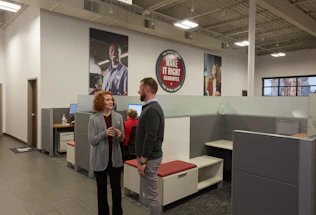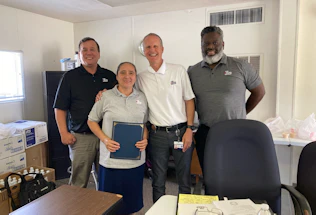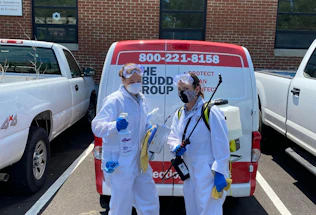Video Transcript:
Halston:
Well, you’ve shown us a lot of really cool projects today. One more I want to ask you about though is as we’ve been walking around and the guys at home can’t see this, but these floors look fantastic. They’re shiny, clean. I mean, you can almost see your reflection. So how are you guys able to do that?
Justin:
Well, there are many, many components to a good floor program. There’s, of course, sweeping, mopping things that are happening generally every day, but then there’s also scrubbing and burnishing and at the root of all of that stuff is stripping and waxing.
Halston:
Gotcha. Stripping and waxing.
Justin:
Yep.
Halston:
So I guess this is machine that does it then?
Justin:
It sure is. This is called the rotary floor machine. These have been around for a pretty long time. These are definitely at the root of floor care. They spin at about 135 revolutions per minute and you can put all sorts of different attachments on there. You can scrub the floor with them, you can scrub tile with them, you can do carpet with them, just a lot of different things go on this machine.
Halston:
Very cool. Why don’t you tell our folks watching, how are we going to use this thing safely? What are some kind of maintenance items we need to look out for to do it safely?
Justin:
Well, there are some things that you definitely want to make sure are done a manager can do in between jobs. When the job is actually started is not the time to be trying to fix a cord or something like that. So kind of a checklist that a manager can go through is at the root of it is the cord. You can see this one is not a clean cord, it’s got some stripper and wax residue on it, but there are no cuts on it. And the next thing you want to look at is even this plug right down here. It’s got a cover on it that slides back and you can see that this plug actually goes into this other piece and if that comes unplugged like that or if it’s hanging out, that could be the same thing as having a cut or something like that in the cord. You’re still talking about electricity and mixing with water, which we all know can have tragic results.
Halston:
[crosstalk 00:02:19] Never good. Never good.
Justin:
And then also this bolt on here is a really important thing. You want to make sure that that is tight. A manager can come through with some channel locks or some type of a wrench and just make sure that that is tight because if that’s not tight, this is the lever that locks the handle up and down. And if that bolt or that nut is not tight on that bolt, you can turn this all day and the handle is still going to move. And that could result in loss of control for the user if they’ve got the handle down and all of a sudden it flies up or something like that.
Halston:
Okay. One more thing I noticed is I think that that plug looks new, that replacement plug, but the cord looks old. So is that a new plug?
Justin:
That is a new plug. These have three prongs on them. You can see I’m pulling out by the actual plug itself and not the cord. But these three prongs are really important. That big one right here in the bottom, that’s the ground plug and a lot of times these will fall out. They fall out because people may try to get 35 feet out of a 30 foot cord and they’re just trying to get just a little bit further with that machine and the pressure pulls that out away from the wall.
Halston:
Very good. Very good. So to me, it looks a little complicated to run this thing. How do you steer at once it’s going?
Justin:
Well, it’s actually a lot easier than it seems. It does take some practice and some good adequate training. You basically you lower the handle and I like to put this somewhere down around my belt and then you want to make sure this is tight all the way so it doesn’t go up and down without you wanting it to go up and down. And then it’s got a start switch right here that you lift up and you squeeze the trigger. I’m not going to do it because it’s plugged in and it’ll turn on, but then once it starts rolling, you just lift up and down to have it go left and right. And then of course, walking is going to make it go forward and backwards.
Halston:
So up is left?
Justin:
Up or down is left and up is right.
Halston:
Okay.
Justin:
There’s no shame and not knowing that off the top of your head.
Halston:
That was good. Yeah.
Justin:
I want to make sure I was right.
Halston:
Very good. Okay, very cool. So before, I want to actually see you run this thing and show us how you would do this room, but before we do that, is there anything, any kind of PPE that you would recommend wearing when you’re doing something like this or any equipment that we would need to get this job done?
Justin:
I am so glad you asked because [Halston 00:04:47], it seems like a lot of places that I go stripping and waxing is such an important part of what we do here at the Budd Group that people kind of disregard the safety things. But stripper, whether it’s mixed up or definitely straight out of the jug can be absolutely corrosive. I’ve seen it eat through paper or styrofoam cups before. That’s how strong this stuff is, so it’s really important that we’re protecting ourselves.
Halston:
Gotcha.
Justin:
Okay. Now this is kind of out of the ordinary, but you want to put on your gloves before you start working. Usually when people are cleaning bathrooms, you want to take them off as you leave the bathroom so that you’re not taking germ from the bathroom and take them out. That’s because you’re trying to prevent the spread of germs. We’re putting these on today simply to protect our hands.
Halston:
Okay.
Justin:
So everything that you do when you’re mixing up your stripper and you’re putting on your, getting ready to go. Basically, you want to have your gloves on because you never know where there’s going to be some old stripper. Maybe it’s on an old shoe cover. Maybe it’s on a funnel. You just, it’s a good idea to have the gloves on.
Justin:
Sort of at the heart of our protection, our shoe covers. These are the shoes for crews use by the Budd Group. These do a really, really phenomenal job for just regular wet surfaces. If you’re just mopping a floor or something like that. There have been some issues with stuff getting built up in these treads and-
Halston:
Uh-huh (affirmative). I see that.
Justin:
Yeah. It’s got … The treads are very, very close together and you’re going to be taken old finish off, mixed with stripper, so it’s going to turn into like a glue and over time, it’s just going to clog these treads up and these aren’t going to do any good. So it’s really important to rinse them out at the end of your shift.
Halston:
Okay. So rinse them out if you want those things to be effective. Otherwise, it’s like wearing ice skates.
Justin:
It is.
Halston:
Okay.
Justin:
That’s exactly the way it is. Another good thing about these is they also protect your shoes.
Halston:
[crosstalk 00:06:49] That’s okay … yeah, good point.
Justin:
Some people don’t want to get their shoes messed up, but these are probably the favorites among everybody that I’ve seen. These just simply strap onto your shoes. Now they don’t do anything as far as protecting your shoes, but this material, feel that Halston.
Halston:
Yeah, it feels exactly like the pad.
Justin:
This is exactly the same material as a stripping pad. And these just do a phenomenal job giving you traction. When you get into the details and the stuff, not just the main floor that you’re going to be doing with the machine, but most floor jobs usually have one or two people going around with like a putty knife or a scraper getting the baseboards and all that stuff. You want to make sure that they’ve got some type of knee protection.
Halston:
Okay.
Justin:
These are just your standard knee pads.
Halston:
So that will protect your knees as well as keeping the chemical off of you.
Justin:
Exactly.
Halston:
Gotcha.
Justin:
And then another thing that a lot of people overlook, but it’s really important that that person who’s down there scraping with a putty knife that’s flexible and bending, has glasses on.
Halston:
That’s right. Keep it from splashing in our eyes.
Justin:
[crosstalk 00:07:53] Because any time I’ve seen it happen, at any time that can, the stripper can get up into their eyes and-
Halston:
Gotcha.
Justin:
… I’ve seen what it does to flesh. I don’t want to know what it does to eyeballs.
Halston:
Absolutely.
Justin:
And then, of course, when it comes time to mixing the stripper, you always want to follow the manufacturer’s instructions as far as the proportion. For those of you who don’t know that, a trick, a really easy way of doing that is taking 128 because that’s the number of ounces in a gallon, and if the solution is calling for a one to four, then you divide it by four. If it’s calling for one to six, you would divide 128 by six and that’s going to give you the number of ounces of stripper you should mix with a gallon of water.
Halston:
Gotcha.
Justin:
I like using these real thin funnels and I know a lot of people like to buy measuring cups from the store and they’re actual measuring cups, but those get lost. Those get misplaced in closets. Everybody’s got these. So you can see that there’s a measuring ounces on there and that’s why you get these, the more narrow funnels because these fit down in there. And then strippers are going to come in a case and you just empty it down in there and you can measure it up. Always have goggles on.
Halston:
I was going to say one thing I’ve seen as well as sometimes you drop it or it hits something or just important, anytime you’re pouring chemicals, no matter what chemicals, make sure we’re wearing goggles.
Justin:
Yes, and I mean, that’s … people who’ve done floors for awhile will tell you that that stripper’s no joke. I’ve gotten it under fingernails and it hurts.
Halston:
Gotcha.
Justin:
And it just keeps on eating away at whatever it’s touching.
Halston:
So we’ve gone through everything here. I think the last thing is why don’t you show us how to use this thing? I know there are a lot of different techniques, but if you would just talk us through and show us what you think is the best way to kind of make your way around a room like this.
Justin:
The route is really, really important. We’re not going to strip this floor today, so I just have a polishing pad on here, but it’s going to, I’ll do the same exact route that I would do if it were soaking in stripper and I was taking the wax off.
Halston:
All right, take it away.
Justin:
All right.
Speaker 3:
After working his way out of the room with the stripping solution, notice how Justin works the perimeter of the room first with the rotary floor machine, to avoid walking in the stripping solution. This gives them a safe walking surface around the room. Then he’s able to strip the middle of the room in a back and forth manner, again, to avoid stepping in this solution.
Speaker 3:
Pro safety tip number two. First, look at the machine. Ensure the cord has no nicks or cuts, is fully intact, and is properly plugged in. Look at the plug and the outlet and make sure they’re safe for use. When stripping a floor, make sure you’re using the proper technique. Hold the handlebars firmly with both hands and at waist level. Move slowly and ensure the cord is out of the way of the machine. Use the right PPE: gloves, shoe covers, knee pads, and eye protection are all necessary throughout this process. Finally, start on the perimeter and work your way in this way. It will avoid stepping on any wet surfaces.
The Budd Group strives to be a God-honoring company of excellence safely delivering services in janitorial, maintenance, and landscaping; offering development opportunities for their employees; and contributing to their community.
Interested in working for The Budd Group? We are hiring and offer benefits!
Find a Job
We have locations in Florida, Georgia, Kentucky, Mississippi, North Carolina, South Carolina, Tennessee, Virginia, and West Virginia.
Please use the links above for applying to The Budd Group for any position throughout our company. However, if you need to contact someone regarding a specific question, please use the phone number or email for the office nearest you from the list below.








